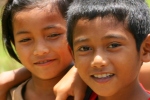After I had walked 5 or 6 kilometres through various villages to Kon Klor, I felt like a member of the Royal family. I must have waved at a couple of hundred people along the way, mainly family groups, with a smile and my badly-pronounced “Xin Chao”. If I did this 200 times, I received a thousand or more bigger smiles and responses of “hello hello” from every child along the way. Every parent laughed and pointed at my camera and then at some unsuspecting friend or relative nearby, or, more often, their children who were always jumping around at the prospect of being photographed. The resulting photos led to gales of laughter from children and parents and requests for more, more, more.
When I finally got to the new rong at Kon Klor some kids. local Montangards, were playing in the locked grounds. They came running over to the gate, all big brown eyes and huge toothy grins. Then they scrambled over the 8 feet high fence, leapt down from the top and demanded photos. The old woman standing next to us with her little sugar cane juice street stall was laughing as much as the kids.
The hardest part was getting them to stand still for a second. They all shoved each other out of the way to get in front of the lens, by which time they were an inch away as I kept retreating. The laughter could have been heard in Hanoi.
There were many stops along the way. At one house in Kontum village, a Ba Na tribal village 2 or 3 kilometres from the middle of Kontum, the entire family was sitting out the front peeling and chopping yams. The new babies, the younger kids, the teenage girls and the parents. The young men were too cool for this and sat in the middle of the dirt road 20 metres away.
All the young girls wanted their photos taken. A young woman arrived who spoke some English. She asked me to send some printed copies. I suggested that I email them to her. She said that she has an email address, but no-one else does, and no-one has a computer so she has to go into town to an internet cafe.
Another stop was at a house next to the rong in the village of Thang Loi. It is a modern, large house, by Vietnamese standards. There were ten or so kids at the front fence and some men were setting up a drum kit and speakers at the front door.
I spoke to the father, a man about 45 at a guess, whose English was pretty good, and asked what the party was for. “A wedding. The bride…” and he just waved a hand vaguely to the upper floor of the house. I gathered that it was his daughter. He asked me to stay for it. “When will it be?” I asked, thinking that it might be in a few minutes. It was then about 11.30am. “Maybe 3 but who knows. When people are here and want it to start. You Australians do everything on time. This is Vietnam. We are not like that”. I knew that already.
I couldn’t stay that long. There was a plane to catch that afternoon at Pleiku to take me back to Saigon and all of its chaos and noise, but the kids at the fence were demanding photos and were making as much chaos and noise as half of Saigon. It would have been a great party.
These children are growing up in a village which is a long way from the development, education, money and opportunities of Saigon or Hanoi, or even smaller cities like Danang and Nha Trang. One of the reasons that they were so happy and enthusiastic at a westerner with a camera is that they have little else to do. It is a simple existence. For most of them there is no modern technology. If there is a TV in the house, the parents choose what to watch. Some were sitting quietly with their mothers and aunties, just sitting there, or peeling and chopping yams, or running around the field surrounding the rong. Besides the ones in these photos there were many dozens more that would have leapt at the opportunity to see their photos on the display screen on the western man’s camera.
They make their own fun, because they have to. They have a natural joyous sense of fun and boundless exuberance. Change will come quickly. In a short time, maybe 2 or 3 years, some of them will have computers and mobile phones. In 5 years most of them will. Many of them, mainly the Vietnamese, will head to Saigon for jobs and money.
The Montangards have less chances to do so. They are much poorer and have fewer opportunities. Home is still very much where the family is, and for many of the girls this includes having babies at very young ages. But some of them will find lives outside the net of poverty and the attendant problems of ill-health and social deprivations. They will send money back to the villages so that others can get educations.
For the moment they are all, Viets and Montangards, beautiful, happy, enchanting kids enjoying the fun of the moment on a sunny Sunday.


























